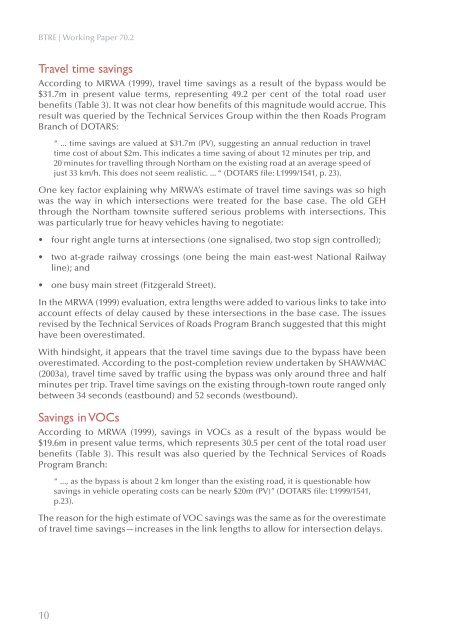PDF: 667 KB - Bureau of Infrastructure, Transport and Regional ...
PDF: 667 KB - Bureau of Infrastructure, Transport and Regional ...
PDF: 667 KB - Bureau of Infrastructure, Transport and Regional ...
Create successful ePaper yourself
Turn your PDF publications into a flip-book with our unique Google optimized e-Paper software.
BTRE | Working Paper 70.2<br />
Travel time savings<br />
According to MRWA (1999), travel time savings as a result <strong>of</strong> the bypass would be<br />
$31.7m in present value terms, representing 49.2 per cent <strong>of</strong> the total road user<br />
benefits (Table 3). It was not clear how benefits <strong>of</strong> this magnitude would accrue. This<br />
result was queried by the Technical Services Group within the then Roads Program<br />
Branch <strong>of</strong> DOTARS:<br />
“ ... time savings are valued at $31.7m (PV), suggesting an annual reduction in travel<br />
time cost <strong>of</strong> about $2m. This indicates a time saving <strong>of</strong> about 12 minutes per trip, <strong>and</strong><br />
20 minutes for travelling through Northam on the existing road at an average speed <strong>of</strong><br />
just 33 km/h. This does not seem realistic. ... “ (DOTARS file: L1999/1541, p. 23).<br />
One key factor explaining why MRWA’s estimate <strong>of</strong> travel time savings was so high<br />
was the way in which intersections were treated for the base case. The old GEH<br />
through the Northam townsite suffered serious problems with intersections. This<br />
was particularly true for heavy vehicles having to negotiate:<br />
• four right angle turns at intersections (one signalised, two stop sign controlled);<br />
• two at-grade railway crossings (one being the main east-west National Railway<br />
line); <strong>and</strong><br />
• one busy main street (Fitzgerald Street).<br />
In the MRWA (1999) evaluation, extra lengths were added to various links to take into<br />
account effects <strong>of</strong> delay caused by these intersections in the base case. The issues<br />
revised by the Technical Services <strong>of</strong> Roads Program Branch suggested that this might<br />
have been overestimated.<br />
With hindsight, it appears that the travel time savings due to the bypass have been<br />
overestimated. According to the post-completion review undertaken by SHAWMAC<br />
(2003a), travel time saved by traffic using the bypass was only around three <strong>and</strong> half<br />
minutes per trip. Travel time savings on the existing through-town route ranged only<br />
between 34 seconds (eastbound) <strong>and</strong> 52 seconds (westbound).<br />
Savings in VOCs<br />
According to MRWA (1999), savings in VOCs as a result <strong>of</strong> the bypass would be<br />
$19.6m in present value terms, which represents 30.5 per cent <strong>of</strong> the total road user<br />
benefits (Table 3). This result was also queried by the Technical Services <strong>of</strong> Roads<br />
Program Branch:<br />
“ ..., as the bypass is about 2 km longer than the existing road, it is questionable how<br />
savings in vehicle operating costs can be nearly $20m (PV)” (DOTARS file: L1999/1541,<br />
p.23).<br />
The reason for the high estimate <strong>of</strong> VOC savings was the same as for the overestimate<br />
<strong>of</strong> travel time savings—increases in the link lengths to allow for intersection delays.<br />
10

















